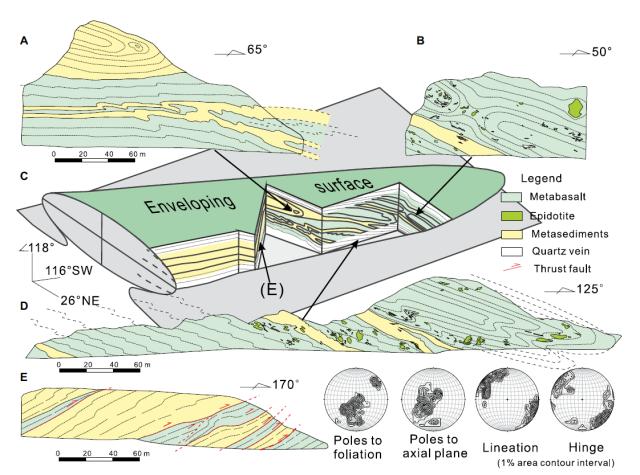近日,我校全球大地构造中心主任Timothy Kusky教授带领的课题组在国际重要学术期刊《GEOLOGY》发表论文“Giant sheath-folded nappe stack demonstrates extreme subhorizontal shear strain in an Archean orogen(太古宙造山带中巨型鞘褶皱推覆堆叠体证实的近水平极高剪应变)”。第一作者为地球科学学院博士生钟亚婷,通讯作者和共同作者分别为地质过程与矿产资源国家重点实验室、地球科学学院和湖北巴东地质灾害国家野外科学观测研究站的Timothy Kusky和王璐教授。

图一: 栅栏状剖面从不同方位穿过鞘褶皱推覆体(局部),从而可从独特的视野观测到推覆体内部核心构造特征
由于缺乏标志性地质证据的约束,早期地球构造体制以及现代板块构造样式的启动时限一直备受争议。经研究对比,Timothy Kusky教授团队认为近水平巨型鞘褶皱这种罕见的构造现象通常与显生宙造山带内大型、长距离逆冲推覆体的侵位有关,如阿尔卑斯造山带中的巨型鞘褶皱,是板块构造体制内地壳近水平应变和位移的产物。近期Timothy Kusky教授团队在华北克拉通太古宙造山带中识别并恢复出公里级别的近水平鞘褶皱推覆体,并将其与全球不同年龄造山带中其他成熟的大型鞘褶皱进行对比。研究表明大规模近水平鞘褶皱是长距离(板块构造)横向位移的标志性证据;显生宙、元古宙和太古宙造山带中均保存着类似的大规模近水平剪切应变和位移,表明在整个地质时期,这些相似的构造可能是在相似的构造体制下通过相似的变形过程形成的。这一研究是目前太古宙首例已知的近水平巨型鞘状褶皱推覆体,为太古宙地质记录增添了现代板块构造模式的另一个特征性实例。
文章详情:
Zhong, Y.T., Kusky, T.M., and Wang, L., Giant Archean sheath folded nappe stack demonstrates large subhorizontal shear strains, North China. Geology. Published online Feb. 25, 2022.  https://doi.org/10.1130/G49599.1
https://doi.org/10.1130/G49599.1
Recently, a research group led by Professor Timothy Kusky, director of the Center for Global Tectonics of our school, published the paper "Giant sheath-folded nappe stack demonstrates extreme subhorizontal shear strain in an Archean orogen" in the internationally important academic journal "GEOLOGY". The work confirms the subhorizontal high shear strain in an Archean orogen, and is the world’s oldest recognized giant subhorizontal sheath fold.” The first author is Zhong Yating, a doctoral student in the School of Earth Sciences, and the corresponding author and co-author are Professor Timothy Kusky and Wang Lu from the State Key Laboratory of Geological Processes and Mineral Resources, the School of Earth Sciences, and the Badong National Observatory and Research Station for Geohazards of the Ministry of Education, respectively.

Figure 1. Fence profile cut through a sheath fold sequence in various orientations allowing unique views into the heart of the structure.
Due to the lack of indicative geological evidence, the nature of the early Earth tectonic regime and of the time of emergence of the modern plate tectonic style has been controversial. After research and comparison, Professor Timothy Kusky's group believes that the rare tectonic phenomenon of near-horizontal giant sheath folds is usually related to the emplacement of large, far-travelled thrust nappes in the Phanerozoic orogens, such as giant sheath folds in the Alpine orogenic belt, and are the product of subhorizontal strain and displacement of the crust in the plate tectonic system. Recently, Professor Timothy Kusky's group identified and recovered a kilometer-scale subhorizontal sheath fold nappe in the Archean orogen within the North China Craton, and compared it with other mature large sheath folds in orogens of all ages around the world. Studies have shown that large-scale near-horizontal sheath folds are indicative of long-distance (plate tectonics) lateral displacements; similar large-scale subhorizontal shear strains and displacements are preserved in the Phanerozoic and Proterozoic (and now, Archean) orogenic belts, suggesting that these similar structures may have formed through similar processes under similar tectonic regimes throughout geological history. This study is the first known example of a subhorizontal giant sheathed nappe in the Archean, adding another feature of modern plate tectonic patterns to the Archean geological record.
Article information:
Zhong, Y.T., Kusky, T.M., and Wang, L., Giant Archean sheath folded nappe stack demonstrates large subhorizontal shear strains, North China. Geology. Published online Feb. 25, 2022.  https://doi.org/10.1130/G49599.1
https://doi.org/10.1130/G49599.1